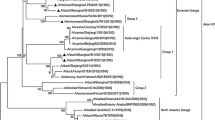Abstract
Four H7N3 avian influenza viruses (AIVs) were isolated from domestic ducks in live-poultry markets in Zhejiang Province, Eastern China, in 2011. All viruses were characterized by whole-genome sequencing with subsequent phylogenetic analysis and genetic comparison. Phylogenetic analysis of all eight viral genes showed that the viruses clustered in the Eurasian lineage of influenza viruses. The hemagglutinin cleavage site of all viruses indicated that the four strains were low-pathogenic avian influenza viruses.

Similar content being viewed by others
References
Webster RG, Bean WJ, Gorman OT, Chambers TM, Kawaoka Y (1992) Evolution and ecology of influenza A viruses. Microbiol Rev 56:152–179
Alexander DJ (2000) A review of avian influenza in different bird species. Vet Microbiol 74(1–2):3–13
Mannelli A, Busani L, Toson M, Bertolini S, Marangon S (2007) Transmission parameters of highly pathogenic avian influenza (H7N1) among industrial poultry farms in northern Italy in 1999–2000. Prev Vet Med 81(4):318–322
Di Trani L, Bedini B, Cordioli P, Muscillo M, Vignolo E, Moreno A, Tollis M (2004) Molecular characterization of low pathogenicity H7N3 avian influenza viruses isolated in Italy. Avian Dis 48(2):376–383
Spackman E, Senne DA, Davison S, Suarez DL (2003) Sequence analysis of recent H7 avian influenza viruses associated with three different outbreaks in commercial poultry in the United States. J Virol 77(24):13399–13402
van Kolfschooten F (2003) Dutch veterinarian becomes first victim of avian influenza. Lancet 361(9367):1444
Koopmans M, Wilbrink B, Conyn M, Natrop G, van der Nat H, Vennema H, Meijer A, van Steenbergen J, Fouchier R, Osterhaus A, Bosman A (2004) Transmission of H7N7 avian influenza A virus to human beings during a large outbreak in commercial poultry farms in the Netherlands. Lancet 363(9409):587–593
Skowronski DM, Tweed SA, Petric M, Booth T, Li Y, Tam T (2006) Human illness and isolation of low-pathogenicity avian influenza virus of the H7N3 subtype in British Columbia. Canada. J Infect Dis 193(6):899–900
Li Y, Li C, Liu L, Wang H, Wang C, Tian G, Webster RG, Yu K, Chen H (2006) Characterization of an avian influenza virus of subtype H7N2 isolated from chickens in northern China. Virus Genes 33(1):117–122
Wu HB, Guo CT, Lu RF, Xu LH, Wo EK, You JB, Wang YT, Wang QG, Wu NP (2012) Genetic characterization of subtype H1 avian influenza viruses isolated from live poultry markets in Zhejiang Province, China, in 2011. Virus Genes 44(3):441–449
Horimoto T, Ito T, Alexander DJ, Kawaoka Y (1995) Cleavability of hemagglutinin from an extremely virulent strain of avian influenza virus containing a unique cleavage site sequence. J Vet Med Sci 57(5):927–930
Lee CW, Lee YJ, Senne DA, Suarez DL (2006) Pathogenic potential of North American H7N2 avian influenza virus: a mutagenesis study using reverse genetics. Virology 353(2):388–395
Yang H, Chen LM, Carney PJ, Donis RO, Stevens J (2010) Structures of receptor complexes of a North American H7N2 influenza hemagglutinin with a loop deletion in the receptor binding site. PLoS Pathog 6(9):e1001081
Gambaryan AS, Matrosovich TY, Philipp J, Munster VJ, Fouchier RA, Cattoli G, Capua I, Krauss SL, Webster RG, Banks J, Bovin NV, Klenk HD, Matrosovich MN (2012) Receptor-binding profiles of h7 subtype influenza viruses in different host species. J Virol 86(8):4370–4379
Liu J, Stevens DJ, Haire LF, Walker PA, Coombs PJ, Russell RJ, Gamblin SJ (1957) Skehel JJ (2009) Structures of receptor complexes formed by hemagglutinins from the Asian Influenza pandemic of. Proc Natl Acad Sci USA 106(40):17175–17180
Helenius A, Aebi M (2004) Roles of N-linked glycans in the endoplasmic reticulum. Annu Rev Biochem 73:1019–1049
Aoki FY, Boivin G, Roberts N (2007) Influenza virus susceptibility and resistance to oseltamivir. Antivir Ther 12:603–616
Deyde VM, Xu X, Bright RA, Shaw M, Smith CB, Zhang Y, Shu Y, Gubareva LV, Cox NJ, Klimov AI (2007) Surveillance of resistance to adamantanes among influenza A (H3N2) and A (H1N1) viruses isolated worldwide. J Infect Dis 196(2):249–257
Hirst M, Astell CR, Griffith M, Coughlin SM, Moksa M, Zeng T, Smailus DE, Holt RA, Jones S, Marra MA, Petric M, Krajden M, Lawrence D, Mak A, Chow R, Skowronski DM, Tweed SA, Goh S, Brunham RC, Robinson J, Bowes V, Sojonky K, Byrne SK, Li Y, Kobasa D, Booth T, Paetzel M (2004) Novel avian influenza H7N3 strain outbreak, British Columbia. Emerg Infect Dis 10(12):2192–2195
Pasick J, Handel K, Robinson J, Copps J, Ridd D, Hills K, Kehler H, Cottam-Birt C, Neufeld J, Berhane Y, Czub S (2005) Intersegmental recombination between the haemagglutinin and matrix genes was responsible for the emergence of a highly pathogenic H7N3 avian influenza virus in British Columbia. J Gen Virol 86(Pt 3):727–731
Acknowledgments
This study was supported by grants from the National Science Foundation of the People’s Republic of China (30872163), National Key Technologies R&D Programme for the 12th Five-Year Plan of China (2012ZX1000-004-005) and the State Key Laboratory of Independent Task. This study was sponsored by Zhejiang Provincial Program for the Cultivation of High-Level Innovative Health Talents.
Author information
Authors and Affiliations
Corresponding authors
Additional information
Wu Hai-bo and Lu Ru-feng contributed equally to the work.
Electronic supplementary material
Below is the link to the electronic supplementary material.
Rights and permissions
About this article
Cite this article
Hai-bo, W., Ru-feng, L., En-kang, W. et al. Sequence and phylogenetic analysis of H7N3 avian influenza viruses isolated from poultry in China in 2011. Arch Virol 157, 2017–2021 (2012). https://doi.org/10.1007/s00705-012-1370-3
Received:
Accepted:
Published:
Issue Date:
DOI: https://doi.org/10.1007/s00705-012-1370-3




